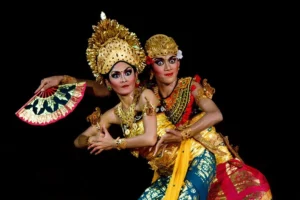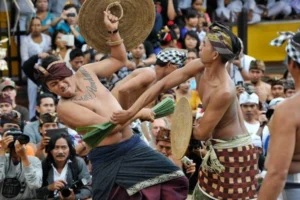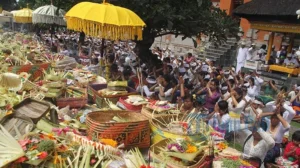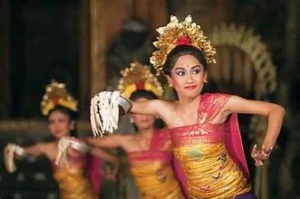In this article, we will explore the heart of Bali’s villages and discover the uniqueness and authenticity of 15 cultural activities that make them so special. From meaningful ritual dances to traditional ceremonial processions, every corner of the village showcases the beauty and richness of captivating traditions. Tourists can directly participate in these activities, mingle with the local population, and feel the warmth and hospitality that characterize Bali. Bali’s villages are not just ordinary tourist destinations; they are journeys through time and culture, offering an unforgettable experience to every visitor seeking more than breathtaking natural landscapes.
15 Local Cultural Activities in Bali’s Villages
1.Melasti Ceremony: Purification Before Nyepi
source : pinterest.com
One of the most significant cultural activities in Bali’s villages is the Melasti ceremony. Typically conducted before Nyepi day, this ceremony is a sacred moment where the community cleanses all ritual paraphernalia and equipment, bringing them to holy places such as the nearest sea or river.
Emphasizing the keyword “Melasti,” this ritual reflects the spiritual depth and belief of the Balinese in spiritual purity. Through a series of meaningful steps, including a procession to bring gods and ritual objects to the water, the Melasti ceremony becomes a tangible form of the Balinese community’s efforts to maintain harmony with nature and spirituality.
The Melasti ritual is not just physical cleansing but also a spiritual offering filled with sincerity and sacredness. In this procession, the Balinese express their gratitude and devotion to God, creating a close connection between man, nature, and spiritual existence. The Melasti ceremony symbolizes not only the purification of physical objects but also a means of cleansing the soul and creating inner peace. The sacredness and uniqueness of the Melasti ceremony make it one of the highlights of the cultural heritage presented by Bali’s villages.
2.Oleg Tamulilingan: A Dance Narrating a Love Story
source : pinterest.com
Oleg Tamulilingan is a traditional Balinese dance that tells a beautiful love story between two cendet birds. This dance is an integral part of the richness of Balinese performing arts, full of grace and symbolism. The gentle and meaningful movements of this dance create a harmonious balance, reflecting the daily life and cherished local wisdom values of Balinese society.
Presented by talented dancers, Oleg Tamulilingan is not just a visual spectacle but also a profound artistic expression. This dance is not only a form of artistic creativity but also conveys the message of beauty and harmony in interpersonal relationships, in line with Balinese culture, which greatly values social and spiritual values. Oleg Tamulilingan, with its graceful movements and accompanying meaning, becomes a symbol of the beauty of Balinese art and culture that thrives and evolves in the diversity and richness of local heritage.
3.Ngaben: Meaningful Funeral Procession
source : pinterest.com
Ngaben, or the funeral ceremony, is an essential part of Balinese societal tradition. This ceremony is not only a final farewell to the departed but also a crucial step in purifying the soul, as perceived by Balinese society. The Ngaben procession brings together family and the local community, united to accompany the spirit to the afterlife with wisdom.
Each element of the Ngaben ceremony has its significance, creating a deep symbolic unity. From the procession of transporting the body to the place of worship to the cremation of the body as a symbol of the soul’s release, each step of Ngaben is performed with respect and sacredness. At the same time, Ngaben also reflects the Balinese Hindu philosophy of the eternal cycle of life and death, where death is considered a step toward higher reincarnation.
The Ngaben ceremony not only reflects the spiritual belief of Balinese society but is also rooted in family and community values. Through the active participation of community members, Ngaben becomes a moment where solidarity and mutual support are clearly manifested. Thus, Ngaben is not just a farewell ceremony but also a cultural event representing wisdom, belief, and camaraderie in the face of the cycle of life and death.
4.Subak: Organized Traditional Irrigation System
source : pinterest.com
One of the distinctive features of Bali’s villages is the traditional irrigation system called Subak. This irrigation system is not just a means to enhance agricultural productivity but is also recognized as cultural heritage by UNESCO. The uniqueness of Subak lies not only in its technical function but also in the underlying philosophy of mutual cooperation.
Farmers in Bali’s villages collaborate to maintain and manage the Subak system. They perform distinctive rituals and ceremonies, emphasizing environmental sustainability and the balance between man and nature. Subak reflects a unique harmony between agricultural needs and environmental preservation, where local wisdom and transgenerational wisdom are the keys to its success.
The sustainability of Subak is not just about maintaining fertile lands but also preserving cultural values and local traditions. Through Subak, the Balinese community not only creates fertile fields but also imparts a deep understanding of human dependence on nature. Subak, with all its uniqueness and philosophy, becomes a concrete example of harmony between man and nature that can inspire sustainable agricultural systems globally.
5.Barong Dance: Battle Between the Lion and the Witch
source : nowbali.co.id
The Barong dance represents a performance depicting the battle between Barong, a mythical lion-headed creature, and Rangda, a terrifying demon. This presentation showcases the beauty of dance movements that entertain not only visually but also carry profound philosophical meanings. Each dance movement between Barong and Rangda is not just a representation of mythological characters but also symbols of the eternal struggle between good and evil.
The Barong dance is not just considered visual entertainment but also a visual manifestation of the cultural and spiritual values of Balinese society. The battle between Barong and Rangda not only creates visual tension but also philosophical meanings about the moral and spiritual struggles of daily life. Additionally, the Barong dance is often integrated into various traditional and religious ceremonies in Bali’s villages, becoming an integral part of the cultural heritage passed down from generation to generation.
In a religious context, the Barong dance is seen as a means of seeking protection against evil forces and a form of respect for the underlying forces of nature. By combining magnificent dance art and deep cultural values, the Barong dance becomes a symbol of the richness of Bali’s cultural heritage that continues to captivate and inspire both the local audience and tourists.
6.Megibung: Eating Together as an Expression of Solidarity
source : trippybali.blogspot.com
Megibung, a communal meal tradition deeply rooted in Balinese society, reflects unity and solidarity in the island’s villages. Whenever Megibung takes place, the village community gathers enthusiastically to enjoy delicious dishes served together on banana leaves. Behind the delicacies of these dishes lies a deeper meaning: an effort to strengthen social bonds among villagers. Megibung serves as a platform for village communities to share joy and enhance their sense of belonging, creating a warm and friendly atmosphere at the heart of Bali’s villages that shapes a unique and strong character in Balinese culture.
7.Perang Pandan: Friendly Battle Amidst the Rice Fields
source : 1001indonesia.net
Bali’s villages uniquely and festively celebrate the tradition of Perang Pandan or Mekare-kare as part of the religious ceremonies, Usaba Sambah. In the midst of fertile rice fields, participants, full of enthusiasm, use sharp pandan leaves to engage in this friendly battle. Although the action may seem intense, Perang Pandan actually creates a symbol of unity and courage, strengthening social ties among the villagers. This tradition is not just a physical demonstration but also suggests a spirit of camaraderie that transcends individuality, reinforcing solidarity in the face of various challenges.
8.Makepung: Joyful Buffalo Racing
source : duniart.com
Makepung, a buffalo racing tradition developed in the Jembrana region of Bali, is not just an ordinary racing competition but a festive and energetic cultural event. During this event, buffaloes adorned with special ornaments participate in a race on a lively track, cheered on by the enthusiastic support of the locals. Makepung is not only considered entertainment but also creates a conducive moment to foster a spirit of camaraderie and healthy competition within the community.
The Makepung tradition becomes a means for the people of Jembrana to celebrate their cultural richness. This buffalo race highlights not only the speed and skill of the buffaloes but also represents the spirit of community and collaboration among the locals. Participants, buffalo owners, and spectators interact with each other, creating a friendly atmosphere that enriches their collective experience. Makepung becomes a symbol of vibrant life and community, reminding everyone of the importance of maintaining social relationships and preserving a fraternal spirit in everyday life.
9.Bantenan: Sacrificial Procession for Safety
source : bali.tribunnews.com
Bantenan, a sacrifice ceremony organized by the Balinese community, is an integral part of their religious life. This ceremony is performed as a form of seeking safety and blessings from God, involving offerings such as banten (rice cones) and sesajen. More than just a ritual, Bantenan has deep meaning as an expression of gratitude toward the Divine.
In the context of Bantenan, offerings are not only intended for God but also as a sign of respect for ancestors and benevolent spirits believed to protect and bless the Balinese community. This ceremony creates space for reflection, remembrance, and respect for the spiritual heritage passed down through generations.
10.Tari Topeng: Profound Masked Theater Show
source : pinterest.com
Bali’s villages become the living stage for Tari Topeng, a traditional theater show rich in cultural values. In each performance, Tari Topeng is not just a captivating artistic spectacle but also summarizes local wisdom and the richness of stories. Each mask used in this dance is not just a tool of expression but also a symbol of a character carrying deep meaning. In Bali’s villages, Tari Topeng is not only handed down from generation to generation but also serves as an effective means to convey moral messages and life values to the community.
In the context of life in Bali’s villages, Tari Topeng is not just an artistic spectacle but also a form of traditional storytelling that enriches local culture. Through graceful and meaningful dance movements, the inhabitants of these villages capture moral messages contained in each performance. Tari Topeng becomes a means that helps preserve and transmit Bali’s cultural heritage, making villages the custodians of local wisdom and the venue for the development of valuable traditional performing arts.
11.Ngrupuk: Carnival Procession
source : nowbali.co.id
Unique to Welcoming Nyepi, Bali’s villages witness the joy and uniqueness of Ngrupuk, a carnival procession held before Nyepi Day. As this sacred moment approaches, village communities come together to participate in a parade adorned with ogoh-ogoh statues representing malevolent figures. Ngrupuk is not just a spectacular visual celebration but also holds deep significance in Bali’s spiritual and cultural context. Through Ngrupuk, Bali’s villages not only celebrate creativity and collaboration in creating impressive ogoh-ogoh but also drive away negative energies that may surround them.
This parade becomes a means for the community to unite, liven up the atmosphere with music, dance, and merriment, all while cleansing and distancing themselves from negative elements before entering a period of reflection and tranquility during Nyepi Day. Villages become the center of Ngrupuk activities, which not only builds collective joy but is also rooted in tradition to create a spiritual and social balance in daily life.
12.Pendet Dance: Elegant Welcome Dance
source : travelasiaindonesia.blogspot.com
The Pendet Dance, a beautiful welcoming dance in Bali, creates attraction through gentle and captivating movements performed by dancers. Presented at various traditional and religious ceremonies, the Pendet Dance represents grace and delicacy, creating an energetic and meaningful atmosphere. This dance becomes a symbol of beauty not only on a physical level but also as an expression of gratitude and happiness for the Balinese community.
Dancers presenting the Pendet Dance not only offer captivating dance skills but also bring spirituality and meaning to each movement. The grace of this dance reflects the cultural richness of Bali and is an integral part of important ceremonies in local life. Through the Pendet Dance, Bali’s villages can showcase the beauty of their traditional art while conveying messages of gratitude and happiness, making this dance a means of rich cultural communication and expression.
13.Nangun Sat Kerthi Loka: Ritual Honoring Nature and Humanity
Nangun Sat Kerthi Loka, a ritual rich in spiritual and ecological values, expresses the Balinese community’s respect and awareness toward nature and its environment. This ritual involves a series of traditional ceremonies designed to honor and seek safety for nature and humanity. During its performance, the Balinese community presents offerings of banten and sesaji as expressions of gratitude and respect for life provided by nature. Nangun Sat Kerthi Loka is not just a traditional ceremony but also marks a deep ecological consciousness rooted in Balinese culture.
By celebrating this ritual, the Balinese community shows concern for the balance of the ecosystem and a willingness to maintain a harmonious relationship with nature. This ritual reflects the philosophy of Tri Hita Karana, the concept of balance between God, man, and nature, which serves as the foundation for the life of the Balinese community. Nangun Sat Kerthi Loka is not just a cultural heritage but also a concrete action to maintain ecological sustainability, reinforcing Bali as a community with close and responsible ties to its environment.
Read also: Best Time to Visit Bali: Guide on Climate, Weather, and Activities
Conclusion
The Bali’s Villages are not just residential areas but also warehouses of cultural heritage wealth. In everyday life, the Balinese community expresses pride in traditional values and local wisdom that are intrinsic to every aspect of cultural activity. From meaningful traditional ceremonies to captivating artistic performances, every corner of Bali’s villages tells a long and varied story about the beauty of local traditions.
The traditional ceremonies held in Bali’s villages are not only religious celebrations but also opportunities to preserve and transmit ancestral values. Through dances, music, and characteristic processions, these villages exude a cultural charm capable of captivating and enriching the experience of every traveler. Bali, with its enchanting nature, is not only a famous tourist destination but also a place capable of imbuing the soul of every visitor who understands and appreciates the uniqueness and beauty of local traditions held by the Balinese community.

















